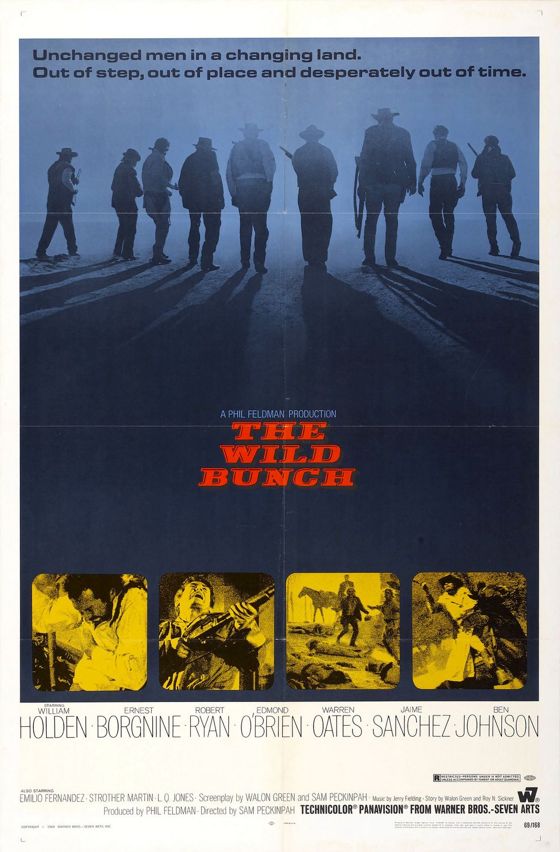
[Note: If you’re a big fan of The Wild Bunch, please don’t read this post — it will really piss you off.]
I know that The Wild Bunch has a lot of cool stuff in it, a lot of cool lines and situations and scenes. I know how startling a film it was when it first came out, because I saw it when it first came out and was startled. I know its historical importance in inaugurating the era of the anti-Western. I know that it was made by a filmmaker of genuine genius and has one set-piece action sequence that’s very close to being brilliant.
But I also know that, overall, it’s badly written, badly shot and badly edited. It’s a mean-spirited, crappy little movie, for all its reputation, and its commentary on the Western genre, its revision of that genre, is puerile and meretricious. It was made by a man who understood and loved the genre but sold his birthright for a mess of porridge.
If your positive feelings about the film are based on viewing it as a young person, then I can understand them — when I was a child I spake as a child, too. But when I became a man, I put away childish things. If your positive feelings about the film are based on a recent viewing and careful consideration, then I either don’t respect your judgment or I don’t like you.
There are some things a man can’t ride around, and for me The Wild Bunch is one of them.
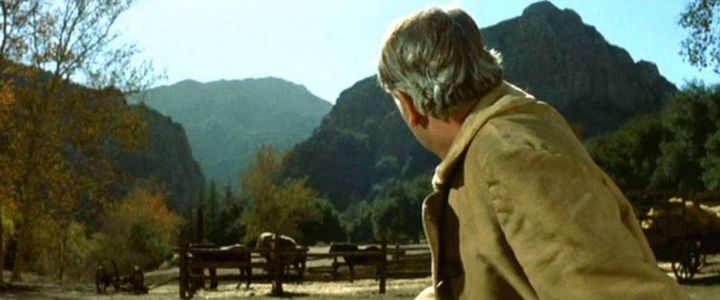
This was Sam Peckinpah’s fourth Western feature. The second, Ride the High Country (above), was one of the great twilight Westerns — a tale of the passing of the West and of the men who tamed it and of the code they lived by. Peckinpah didn’t write that film. He did co-write The Wild Bunch. It has elements of the twilight Western. Its protagonists are aging outlaws off on one last adventure just before WWI — but these men have only the crudest sort of code, which basically boils down to the idea that there should be honor among thieves.
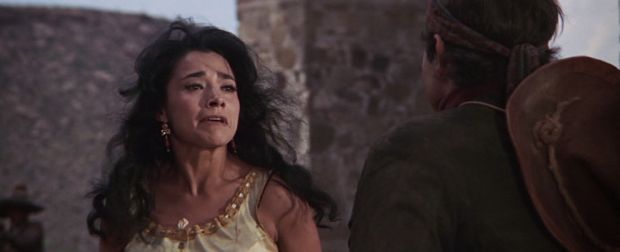
They think nothing of murdering innocent bystanders to get what they want. They tolerate one of their band murdering a former lover because she’s left him for a crud. They’re content to murder U. S. soldiers in order to steal weapons for a corrupt Mexican tyrant, in return for cash. They’re not above using unarmed women as shields in a gunfight.
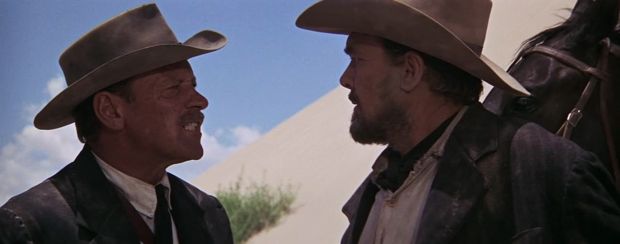
Yet somehow Peckinpah sees honor in these men — because they like to do things the hard way (why?) and because they stick together. In a famous scene, the leader of the outlaw band played by William Holden says, to quell an argument in the ranks, “When you side with a man you stay with him. If you can’t do that you’re just some kind of animal — you’re finished.” But if you side with a man in order to do bestial things, what the hell does a code like that add up to? Nothing much, really.
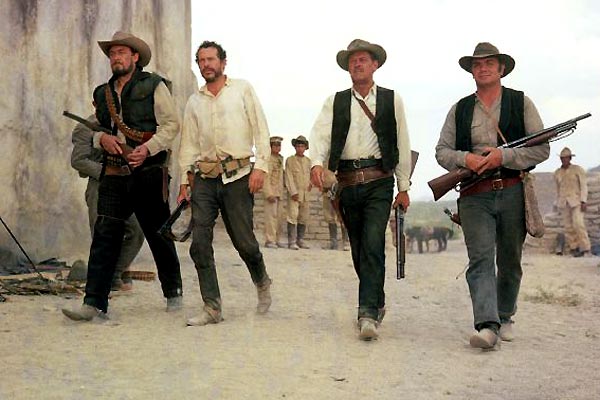
The film ends on a note of sacrificial bravery, or suicide by Federales, if you want to look at it that way, and it summons up enough of the old Western imagery to make you forget for a moment the real character of these men, brave but unprincipled by any conventional or admirable definition of the word, sort of like modern-day terrorists. Peckinpah offers an image of redemption that may fire the blood but cannot convince the heart.
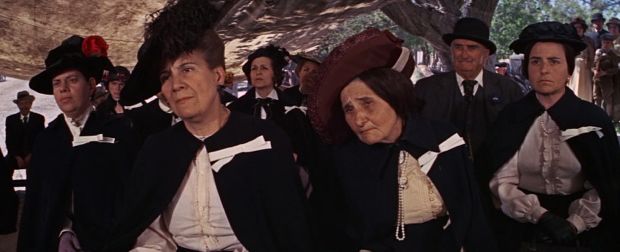
It being 1969, Peckinpah the screenwriter offers other apologies for the brutality and cynicism of his protagonists. The bystanders they kill are part of a hypocritical and corrupt society. The soldiers they kill are incompetent and of course, by implication, wear the uniform of the country that was at the time ravaging Vietnam.
It’s all crap of course — an attempt to burnish male violence and misogyny with some sort of vague social criticism. The outlaws make crude jokes amongst each other and then laugh really hard over them — when you hear that totally unconvincing laughter, you know it’s just a cue to the young men in the audience to approve their own lowest locker-room sensibilities. In the paean to the men that ends the film, Peckinpah offers this rough-house laughter as a kind of transcendent image of the life force of the outlaws. It still rings hollow.
Peckinpah indulges his own adolescent insolence frequently in the film. He knows how to make beautiful shots of horses moving through landscapes, but his big equestrian stunts are all about tormenting horses and making them look awkward and ugly.
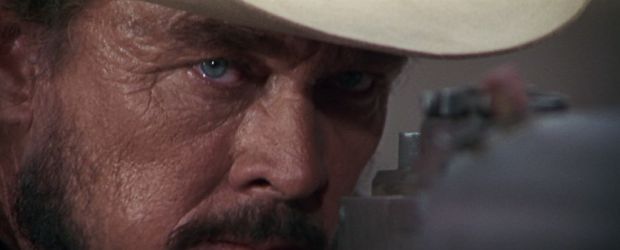
He seems to take a special delight in degrading the aging icons of the Western genre, having them do shameful things — Holden occasionally but Ben Johnson often . . . Johnson who had been for John Ford the symbol of grace in the saddle and moral grace as a hero. To show Johnson’s character drunk in a tub of water pawing a half-naked Mexican whore is to direct a gob of spit straight into Ford’s one good eye.
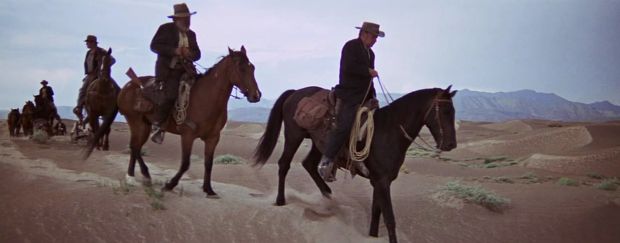
There are many beautiful images in the film, but many more which are turned into mush by telephoto lenses and zooms.
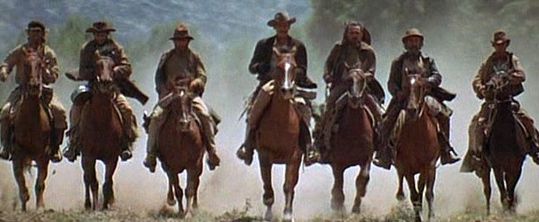
This style of shooting made the film seem new — in 1969. Today, it simply dates the work, making it look cheap, like something shot for television.
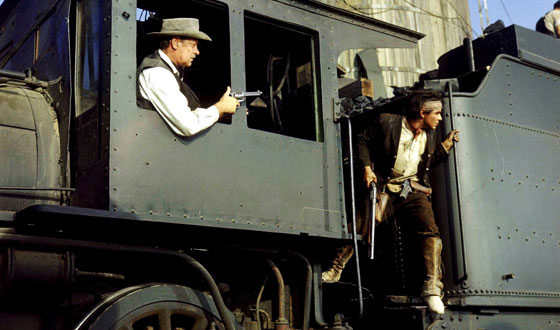
There is one almost wholly admirable set-piece involving a train robbery, which is well staged and well shot and well edited — it’s the work of a filmmaker who knows what he’s doing. But other action sequences are incoherent to the point of being unreadable, with fast cutting and shock zooms that give the impression of excitement by purely cosmetic means.
The film does have a few gracious moments — crepuscular mood pieces in which the nostalgia for past times is almost touching . . . would be touching if we could imagine that these men had ever been more than thugs. And there’s a mystical love for Mexico, for the sweetness of certain aspects of Mexican culture, that really is touching, even if it hasn’t got much to do with the rest of the film.
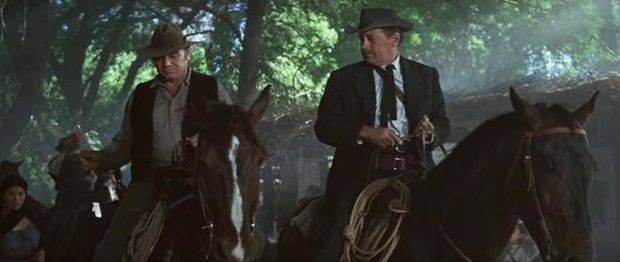
After an initial robbery gone wrong the “wild bunch” retreat south of the border and have a brief idyll in a small Mexican village. As they ride out of it the next day the villagers serenade them, and Peckinpah films their mounted procession in beautiful slow tracking shots. It doesn’t make a lot of sense — why do the villagers seem to worship such men as departing gods? — but it’s very sweet.
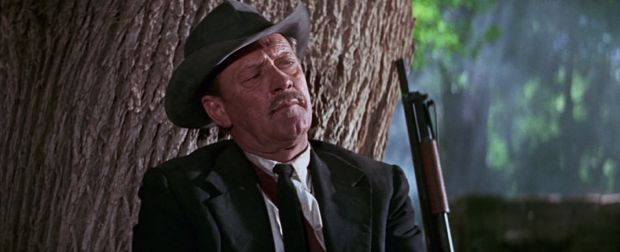
The Wild Bunch got its juice when it came out from its graphic violence and its swaggering nihilism — for its daring in deconstructing the myth of the old West created over generations in the movie Western. That sort of frisson has a short shelf life, though. The anti-Western cycle that this film inspired exhausted itself very quickly, and soon the Western was more or less finished as a commercial proposition. How many times can you deconstruct something that’s already lying scattered around in pieces on the ground?
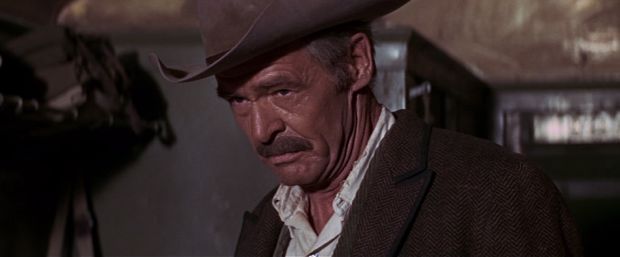
Guys who thrilled to this film in their youths may have a certain nostalgia for its crude, chaotic energy, like the crude, chaotic energy of adolescence itself — and we can’t very well begrudge them this. But it’s no movie for grown men, and it was a calamitous event in the history of the movie Western and thus in our culture at large.

Pingback: Lloyd Fonvielle on A.I. | Uncouth Reflections
Correction. This was Peckinpah’s fourth Western. the first was “The Deadly Companions.”
Thanks, Bill — correction made.
The western had been floundering for several years before The Wild Bunch was released in 1969. The last one of any substantial note was John Ford’s Cheyenne Autumn in 1964. The popularity of the Italian Westerns that started flooding the market in 1966 were the real reason the American Western began to adopt an amoral atmosphere in which its violent protagonists became the new heroes. But remember that the only such hero in the Wild Bunch was Holden’s Pike Bishop. The rest of the gang was shown to be just as vile as Ride the High Country’s Hammond Brothers. The vulgarity of Ben Johnson and Warren Oates with the Mexican whores was meant to stand in contrast with Holden’s gentlemanly treatment of his whore, from whom he took his first bullet in the final showdown. The movie is all about Pike Bishop, and the final massacre functions primarily as an overture to Bishop’s death, a scene that is just as sad as Joel McCrea’s falling out of frame in Ride the High Country.
Can’t agree with you on this, Bill. Pike Bishop was the guy who said, in the opening bank robbery, “If they move, kill them.” He was willing to kill innocent men and women to steal some money. He was as much a monster as any other member of the Wild Bunch. Peckinpah tried to have it both ways in the movie — to endow characters who were utterly cynical and vicious with the aura of Western heroes. It was at bottom a fraudulent ambition.
Bishop wasn’t saying anything that wasn’t said by every other movie bank robber, so i don’t see this as particular to The Wild Bunch. As far as movies about bank robbers go, Bonnie and Clyde, which preceded The Wild Bunch, lacked even the limited morality of Bishop’s code. I am not trying to minimize Pike’s criminal soul, but this doesn’t negate the existence of a moral hierarchy within the group itself, as well as the contrast between the outlaws and the railroad men who were responsible for the massacre at the beginning of the movie, as they didn’t care about the innocent bystanders being killed in the crossfire of their ambush of the bank robbers. It is not so much that Peckinpah tries to make the bad guys look good, as that he makes the good guys also look bad, blurring the line that was so pronounced in the pre-1965 Westerns. Above all, the story is high tragedy, and tragic heroes are never all-good.
You are right on at least one count. There is no redemption here. as there was for Randolph Scott in Ride the High Country.
Peckinpah seemed to think that the corruption of the authorities somehow justified or minimized the corruption of the bad guys. I find this view unpersuasive. I can’t see the film as a tragedy. Some jerks go out bravely, but they’re still jerks.
As I’ve written elsewhere, the 9/11 hijackers went out bravely. They were still jerks.
You write of Pike Bishop as if he were a real person,and not a movie character. This indicates the writer and director did a pretty good job of making you believe in him, . For the record, here is the description of the character from the original screenplay (not the shooting script)
Make no mistake, Pike Bishop is not a hero — his values are not ours — he is a gunfighter, a criminal, a bank. robber, a
killer of men. His sympathies are not for fences, for
trolleys.and telegraphs or better schools. He lives outside
and against society because he believes in that way of life and if he has moments of sympathy for others, moments of regret, they ‘ are short lived. He is not a ‘good man’ according to the righteous… To them he is totally bad, and he wouldn’t have it any other way.
And finally, I don’t see how those 9/11 savages went out bravely. Neither do i see anything brave in the last stand of The Wild Bunch. Their end was their destiny..those who live by the gun shall die by the gun. And they are myth, not real, coming from a tradition of tragic literature going back to the Iliad.
The 9/11 jerks were real people, and they died as cowards, the remnant of a barbaric civilization that should have rotted into the dust and been blown away into oblivion centuries ago.
I write about Bishop as a movie character who is a crud, lives as a crud and dies without redemption. I don’t see anything tragic in that, or any kind of mythology worth embracing.
i worry more about the immediate social effects of cruds that are embraced by people today such as hannibal lector and the whole crew of breaking bad rather than outlaws in an old western.
“But I also know that, overall, it’s badly written, badly shot and badly edited.”
We can disagree on the content but not on the form. It is masterly film-making. You gotta at least admit that much. And what a score by Jerry Fielding.
letania.blogspot.com/2015/05/walon-green-sam-peckinpahs-wild-bunch.html